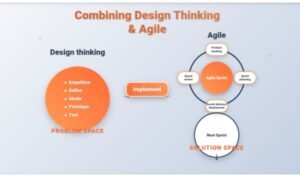✔️ Introduction
In today’s competitive business environment, organizations constantly search for methodologies that accelerate innovation, ensure customer satisfaction, and enhance product quality. Agile methodologies and Design Thinking are two proven approaches embraced by industry leaders worldwide. Individually, each method provides unique benefits—Agile emphasizes adaptability and iterative progress, while Design Thinking places customer needs and human-centric solutions at the forefront.
But what happens when Agile and Design Thinking are combined? This strategic fusion offers organizations unparalleled opportunities to enhance innovation, drive continuous improvement, and deliver superior value to customers. In this comprehensive guide, we delve deeply into how Agile and Design Thinking complement each other, practical strategies for integration, real-world examples, and tips for implementation.
✅ Understanding Agile and Design Thinking
To effectively combine Agile and Design Thinking, let’s first understand their core principles and methodologies.
➡️ What is Agile?
Agile is an iterative project management methodology emphasizing flexibility, collaboration, rapid feedback, and incremental delivery. Agile methodologies such as Scrum, Kanban, and XP (Extreme Programming) aim to:
- Quickly respond to change.
- Foster continuous improvement.
- Prioritize user needs through frequent delivery cycles.
Agile teams work in short, iterative “sprints,” allowing for frequent reassessment and adaptation based on user feedback.
➡️ What is Design Thinking?
Design Thinking is a human-centered approach to innovation that systematically addresses complex problems by empathizing with users. It includes five essential stages:
1. Empathize: Deeply understand user needs through observation and interaction.
2. Define: Clearly articulate the problem.
3. Ideate: Generate innovative ideas through brainstorming and creativity techniques.
4. Prototype: Create tangible representations for solutions.
5. Test: Validate prototypes by gathering user feedback and refining solutions.
✅ Why Combine Agile and Design Thinking?
Combining Agile and Design Thinking capitalizes on their complementary strengths. Agile’s iterative approach reinforces Design Thinking’s focus on continuous improvement and experimentation. Design Thinking ensures Agile stays customer-centric, mitigating the risk of delivering functional products that don’t address real user needs.
➡️ Key Benefits of Combining Both Approaches:
- Enhanced customer focus: Design Thinking’s empathy and user-centric approach ensure Agile projects address genuine customer needs.
- Rapid innovation: Agile iterations combined with Design Thinking’s ideation and prototyping quickly validate and refine ideas.
- Reduced risk: Early feedback and continuous validation significantly decrease the risk of product failure or low adoption.
- Higher quality outputs: Integration of frequent user feedback ensures solutions are refined consistently throughout the project lifecycle.
✅ Strategic Steps for Integrating Agile and Design Thinking
Combining Agile and Design Thinking effectively requires strategic integration. Here’s a structured approach to blend both methodologies into your projects:
➡️ 1. Initiate with Design Thinking (Empathy and Definition)
Begin your project by leveraging Design Thinking to deeply understand user challenges and define clear problems to solve.
- Conduct user research and gather qualitative and quantitative data.
- Organize user interviews, surveys, and observations.
- Develop clear personas, empathy maps, and customer journey maps.
➡️ 2. Ideate and Prototype with Design Thinking
Use Design Thinking to ideate innovative solutions and rapidly prototype low-fidelity solutions for initial feedback before moving into Agile development sprints.
- Facilitate ideation sessions encouraging cross-functional collaboration.
- Use rapid prototyping techniques (storyboards, sketches, mockups).
- Conduct initial user testing of prototypes before investing in development.
➡️ 3. Implement Agile Sprints for Iterative Development
After initial prototyping and validation, adopt Agile sprints to deliver incremental improvements continuously.
- Break solutions into prioritized user stories.
- Use sprint planning sessions to align on deliverables.
- Maintain constant communication via daily stand-ups, sprint reviews, and retrospectives.
➡️ 4. Continuously Test, Validate, and Iterate
Leverage Agile and Design Thinking in tandem, frequently validating deliverables to remain aligned with user needs.
- Conduct usability testing during each sprint.
- Regularly revisit empathy and customer journey maps based on ongoing feedback.
- Adapt and pivot quickly when validation uncovers new user insights.
✅ Challenges and Solutions in Integration
Successfully integrating Agile and Design Thinking isn’t without challenges. Here’s how to navigate common pitfalls:
➡️ Challenge 1: Conflicting Mindsets
Issue: Agile teams may focus excessively on delivery speed, while Design Thinkers emphasize careful exploration and empathy.
Solution: Balance rapid iteration (Agile) with user insights validation (Design Thinking). Regular cross-team communication bridges this gap.
➡️ Challenge 2: Overlapping Processes
Issue: Agile and Design Thinking cycles sometimes overlap, causing confusion and redundant efforts.
Solution: Clearly define roles, stages, and integration points to eliminate redundancy. Map a unified project lifecycle combining both methods explicitly.
➡️ Challenge 3: Maintaining Customer-Centricity
Issue: Agile’s rapid delivery risks losing sight of genuine customer needs.
Solution: Regularly revisit empathy and user insights throughout sprints, maintaining a clear customer-focused perspective.
✅ Best Practices for Successful Integration
Here are key best practices for effectively integrating Agile and Design Thinking:
✔️ Foster open collaboration across Agile and Design Thinking teams.
✔️ Clearly articulate integration points between methodologies.
✔️ Promote user-centric culture through frequent customer interactions.
✔️ Balance iterative speed with deep user validation.
✔️ Conduct regular cross-functional retrospectives to optimize integration continuously.
✅ Conclusion and Future Trends
Integrating Agile and Design Thinking is more than a strategic decision—it’s a powerful recipe for sustained innovation, customer satisfaction, and competitive advantage. By effectively blending the rapid iteration of Agile with the empathetic, human-centric approach of Design Thinking, organizations significantly increase their ability to deliver high-value solutions consistently.
Looking ahead, trends indicate more businesses will adopt combined methodologies, making Agile-Design Thinking hybrids standard practice in project management. Forward-thinking organizations that embrace this synergy today will lead the market, delivering solutions that consistently exceed customer expectations and drive sustainable growth.
